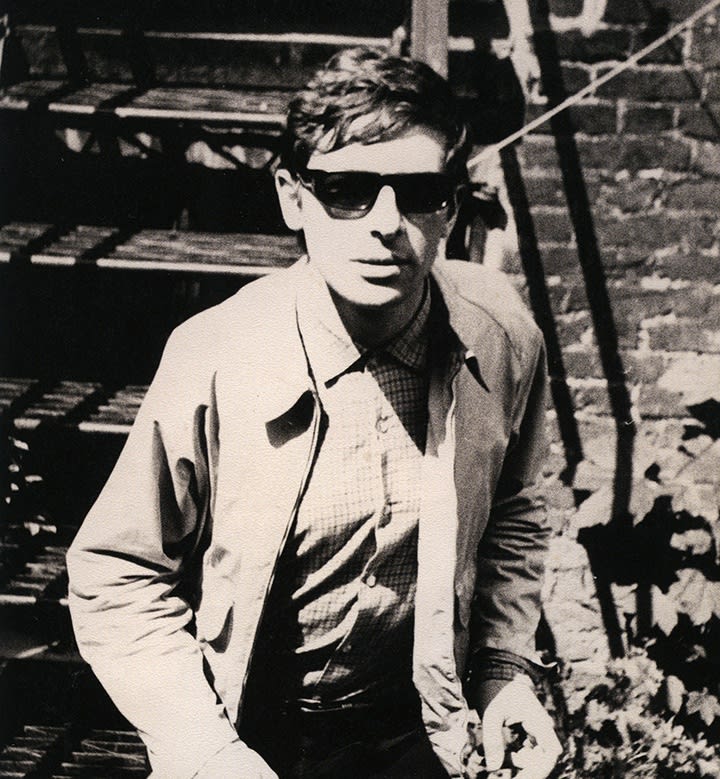
In this article we introduce the work of Barry Martin, with particualr reference to his paintings from the 1970s which are the subject of a major new exhibition in our London gallery (5th - 29th October 2021)
Barry Martin was born in 1943 and grew up in Hertfordshire and Kent before commencing his studies at Goldsmith’s in London in 1961. After leaving Goldsmith’s in 1966, he embarked enrolled on the Advance Sculpture course at St Martin’s but he found himself constantly frustrated with the environment there, staying for just the one year. He was very much a product of the art schools during the ‘swinging sixties’. In keeping with the wild experimentation of the time, during his early career he produced works in a diverse array of media. Bryan Robertson, writing in Art Monthly in 1978, noted that “he tackled everything with vigorous intelligence: art for Martin has been divided into practice and not so much theory as intellectual debate, spoken or written, but this range of activity has probably clouded any accurate public view of his identity as an artist.”
That an artist might develop differing methods with which they convey their ideas is not unusual even when these seemingly contrasting styles are deployed concurrently. Martin’s oeuvre includes figurative and abstract paintings and drawings, but also includes kinetic, sculptural and performance pieces. Indeed, Julius Bryant proclaimed that “Barry Martin became the most versatile and prolific British exponent of Kinetic Art in London in the ‘Swinging Sixties’ and early Seventies.”
While at Goldsmith’s, Martin studied under Albert Irvin, Kenneth and Mary Martin and Dorothy Mead, artists whose own work differed radically from each other. It was his connection to Mead (whose estate Waterhouse & Dodd represent) that brought Martin to Waterhouse & Dodd initially. Mead was to provide a profound early influence on Martin’s work.
Robertson has commented on Martin’s early graphic and painted works, stating that “some of his earlier works can be seen as exercises in style, but the best of them have a consistent concern for the interaction between light and colour, the possibilities of construction, and the abilities to sustain very refined surfaces, textures and narrow gradations of tone.” These concerns, developed first as a student and then through his early career, are central to all his work and across all areas of his practice.
The paintings we have selected for the current presentation date largely from the mid-1970s. Despite still being in his early 30s, Martin had established himself firmly within the art world both as an artist and as a commentator on the visual arts through the establishment of the journal One, which Martin edited between 1974 and 1976. He had also embarked on a prolonged period of producing 2-dimensional abstract work, and developed a sophisticated painting style with which to examine and develop his artistic interests. Robertson describes very succinctly a number of the works we are exhibiting as such: “(the paintings display) parallel and vertical bands of colour, very near in pale tone, (that) combine with contrasting diagonal bands, equally delicate in tone, to make a lattice-like structure in which an amorphous patch of deeper colour looks, behind these bars, almost like a trapped presence.”
Martin often used a vertical format in his abstract paintings during the 1970s. The grid patterns have a gateway structure with contrasting colours and forms that reinterpret the viewer’s traditional experience of light and space. Martin wrote that the experience of viewing these works “can trigger cognitive and perceptual experiences outside of the norm, and expand our understanding of who we are, how do we occupy and stand in space (given the richness and the newness of the experience).” Commentators have referenced the grids as a cage or mesh that contains human experience. Martin views his work as celebratory, essentially offering a means of exploration whereby the viewer is freeing themselves “from the constraints of normality and leaping out of the box.”
These paintings, despite being created almost 50 years ago, feel fresh and contemporary now. Our exhibition provides collectors and visitors a rare opportunity to see a group of these works together for the first time since his exhibitions at the Hoya Gallery during the 1970’s. In one review of a Hoya Gallery show, Fenella Crichton commented that “Martin’s organisation is strong enough to withstand the truculence of his paint application.” She goes on, rather memorably, to say that “his paintings are tough without being stupid, which is rare enough today.” His works have been included in survey shows at the Henry Moore Institute, the Serpentine Gallery, the Victoria & Albert Museum and at Leeds City Art Museum (as well as numerous international venues). His work will also be the subject of a major solo exhibition at the Pratt Institute in New York in 2022.
In addition to his art (and his work with One), Martin has also taught widely including at the Royal College of Art, The Slade School of Fine Art, the Royal Academy Schools, Goldsmith’s College, Central St. Martins College of Art, Croydon College of Art and the Universities of Reading, Manchester, Newcastle and Kingston. Martin is also a passionate and accomplished chess player (and a published author on the subject). Martin’s work can be found in many major public and private collections including the Tate Gallery, the National Portrait Gallery, the Arts Council of England, Henry Moore Institute, the Northern Arts Association, the British Museum, the Victoria & Albert Museum, the Science Museum, the Museum of Modern Art, Paris, the Zaragoza Museum of Fine Art, Spain, the London Hospital Arts Trust, The Government Art Collection, English Heritage, University of London Goldsmith’s College, and City University London. In 2008 a major publication about his work; ‘The Tomorrow Of My Yesterday – The complete works of Barry Martin’, was written by Julius Bryant and published by published by Veeman (Holland).